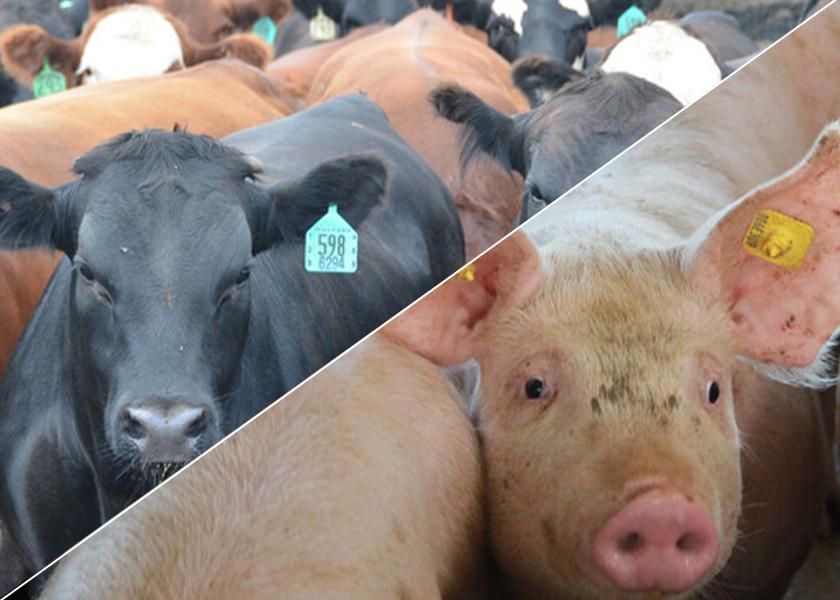Livestock Analysis | May 20, 2022

Price action: June lean hog futures rose $3.575 to $108.875, the contract’s highest closing price since April 28. July lean hogs rose $2.025 to $109.00, up $7.80 for the week.
5-day outlook: Today’s technically bullish “outside day” up on the daily bar charts and bullish weekly high closes in nearby futures set the table for followthrough buying early next week. This week’s price action in both cash and futures solidified notions near-term market lows are in place and that prices can continue to trend sideways to higher in the coming weeks. The CME lean hog index rose 29 cents to $100.37 (as of May 18), the highest in a week. Thursday’s (May 19) preliminary hog index quote is $101.17, up 80 cents from Wednesday. Summer hog futures are now holding solid premiums to the cash index, suggesting the cash hog market can continue to improve in the near term. Pork cutout values early today rose $5.18 to $108.64, led by gains in hams. Movement was decent at 160.27 loads.
30-day outlook: Seasonals suggest hog market price strength in the weeks ahead, amid the summer grilling season and expected lower slaughter numbers as projected by USDA. Less-expensive pork cuts compared to beef could see better consumer demand amid soaring gasoline prices at the pump, a slumping stock market and growing ideas the U.S. economy will slip into recession in the coming months.
90-day outlook: USDA reported net weekly U.S. pork sales down 8% from the previous week but up 2% from the prior four-week average. U.S. pork exports must strengthen for cash and futures markets to see sustained price advances. The U.S. dollar index this week fell from a 20-year high, which could encourage buyers based on ideas dollar-denominated commodities will cheapen. But seasonally increasing hog and pork supplies after midsummer, as well as diminishing consumer demand for the various grilling cuts, often lead to substantial cash market declines as summer passes.
What to do: Cover all soybean meal needs in the cash market through May. Be prepared to extend coverage on further price weakness. You are hand-to-mouth on corn-for-feed needs.
Hedgers: Carry all risk in the cash market for now.
Feed needs: You have all soybean meal needs covered in the cash market through May. Be prepared to extend coverage on price weakness. You are hand-to-mouth on corn-for-feed needs.
Price action: June live cattle rose 7.5 cents to $131.575, down 50 cents for the week. August feeder futures fell $1.275 to $163.925, down $4.10 for the week.
5-day outlook: Cash cattle prices edged upward again Thursday, with the Monday-Thursday average reaching $140.26, but the four-day figure came up $2.13 under the comparable week-prior result. Given June futures ending the week at $131.575, the industry is rather clearly expecting much more of the same over the next six weeks. Given that grocers have likely completed most of their beef buying for Memorial Day weekend, recent wholesale strength will probably diminish, if it doesn’t give way to short-term losses. Bears haven’t been able to decisively force a June futures drop below stout support around $131.00, but such a move could trigger a substantial followthrough to the downside.
USDA Cattle on Feed Report today may generate pressure on live cattle futures early next week. April feedlot placements were expected to fall 4.6% below the comparable year-ago figure, but USDA estimated placements down just 0.9% from last year. April marketings at 1.893 million head (down 2.2% annually) essentially matched expectations for a 2% drop. The May 1 feedlot inventory was 11.967 million head, up 2.0% from last year, whereas a 1.3% year-to-year drop was anticipated.
30-day outlook: Grocer beef buying for planned features usually declines in late May, then improves during the first half of June as they look forward to Fathers’ Day and Independence Day celebrations. Given the greatly elevated cost of retail beef and its negative impact upon consumer demand, the strength of their buying next month is open to question. Seasonally, large fed cattle supplies historically tend to combine with diminished demand to drag cash cattle prices lower during June. We see little reason to expect a divergence from that pattern this year. Exaggerated late-May and/or early-June cash losses could amplify seasonal futures weakness, but more modest cash declines could help the discounted nearby contracts stabilize.
90-day outlook: Cattle slaughter and beef production tend to decline from peak levels reached in late June and/or early July, but summer heat also tends to stifle consumer demand for beef. Those phenomena tend to depress cash cattle prices and limit upside potential in cattle futures. Given the current inflationary environment, we see little reason to think grocers will significantly reduce their asking prices for beef, which in turn could keep a lid on rally attempts as well. Elevated premiums in deferred live cattle and feeder futures also seem likely to encourage laggardly feedlot marketings, which are not conducive to sustained rallies either.
What to do: Cover all soybean meal needs in the cash market through May. Be prepared to extend coverage on further price weakness. You are hand-to-mouth on corn-for-feed needs.
Hedgers: Carry all risk in the cash market for now.
Feed needs: You have all soybean meal needs covered in the cash market through May. Be prepared to extend coverage on price weakness. You are hand-to-mouth on corn-for-feed needs.






